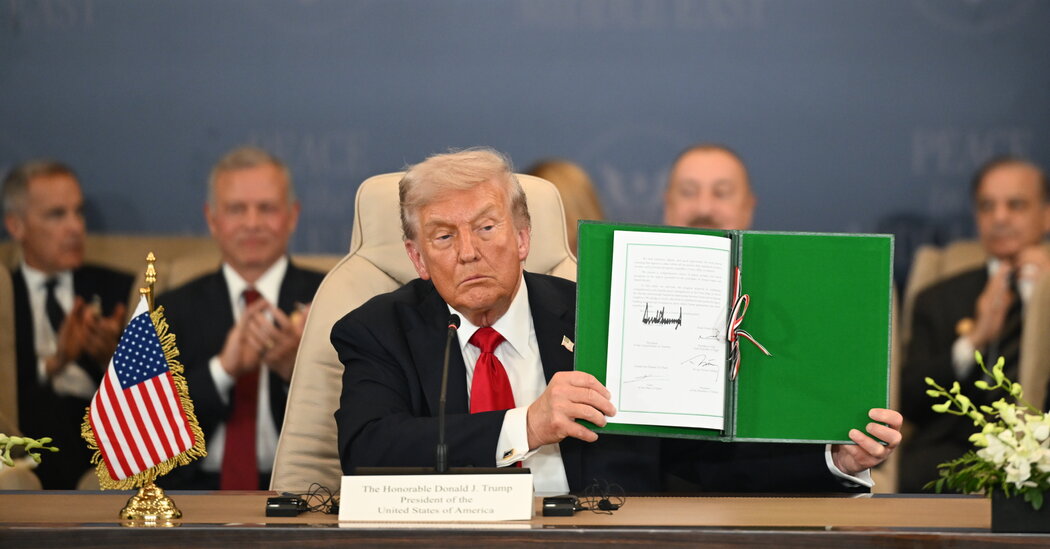At a high-profile conference of world leaders in Egypt about ending the war in the Gaza Strip, President Trump and the leaders of three other nations made a big production out of what he called “a very important signing,” characterizing it as a major breakthrough in the decades-long search for peace between Israelis and Palestinians.
But what is actually demanded from its signatories in the document they signed remains unclear, despite the very public ceremony. “We’re going to be signing a document that’s going to spell out a lot of rules and regulations and lots of other things,” Mr. Trump said just before the signing. “It’s very comprehensive.”
Mr. Trump offered no insight on the substance of their agreement and he barely mentioned the two warring parties, Israel and Hamas. Neither were represented at the conference. The signatories were the United States, Qatar, Egypt and Turkey, all of whom played a role in brokering a cease-fire and hostage-for-prisoners exchange last week.
“We’ve already signed documents in the Middle East having to do with Israel and Hamas and just about everything else,” Mr. Trump said.
Seated at a table along with Egypt’s president, Abdel Fattah el-Sisi; Turkey’s president, Recep Tayyip Erdogan; and the Qatari emir, Sheikh Tamim bin Hamad al-Thani, Mr. Trump was effusive in his praise of these leaders and their efforts to broker a truce in the two-year war in Gaza.
Behind the table with the signers sat other world leaders, including Prime Minister Keir Starmer of Britain and his Canadian counterpart, Mark Carney. Green folders with the document had been placed in front of the heads of state at the table, and a hush fell over the room. Momentarily, only the sound of pens on paper could be heard.
When Mr. Trump held up his folder showing the signed document, the audience applauded.
By zooming in on the page that Mr. Trump held up, it’s possible to see what is written above the world leaders’ signatures. It appears to be a general declaration of principles.
“We welcome the progress achieved in establishing comprehensive and durable peace arrangements in the Gaza Strip, as well as the friendly and mutually beneficial relationship between Israel and its regional neighbors,” the document states.
The leaders pledged to “work collectively” to implement and sustain peace for future generations. There was no indication of how precisely they intend to accomplish these goals, leaving observers with little more than they had when Mr. Trump late last month unveiled a 20-point plan to end the conflict in Gaza.
Israel and Hamas last week agreed to the initial phases of that plan, including the current cease-fire and an exchange of the last Israeli hostages for Palestinian detainees, which occurred on Monday.
But there are unresolved points to be negotiated later. It’s unclear, for instance, if Hamas will ever accept Mr. Trump’s demand for it to disarm and not have a future role in governing the Gaza Strip.
Another question is whether the cease-fire will hold.
Mr. Trump told the summit attendees that the deal was progressing into the next phases. “It’s being worked on right now as we speak, and we’re actually in stage three and four,” he said. He also mentioned, without much explanation, that “we can take them out of order in a positive way,” referring to the phases.
Despite the many questions, leader after leader stepped up to praise Mr. Trump and the peace plan.
The White House, later on Monday, released a document entitled “The Trump Declaration for Enduring Peace and Prosperity,” that appeared to be a full version of the document, though not one with substantive details.
“We, the undersigned, welcome the truly historic commitment and implementation by all parties to the Trump Peace Agreement, ending more than two years of profound suffering and loss — opening a new chapter for the region defined by hope, security, and a shared vision for peace and prosperity,” it began.
Erika Solomon contributed reporting.


